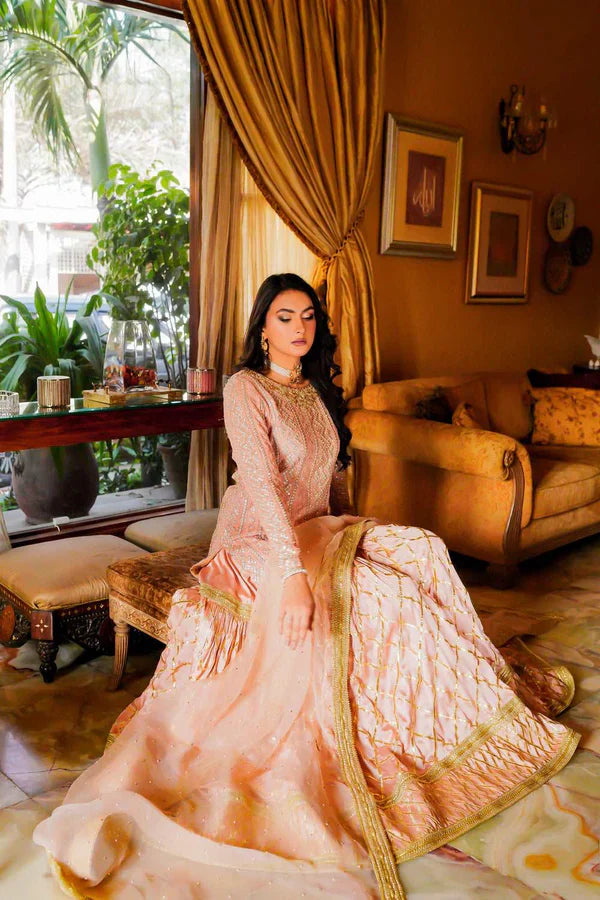
Hina Rathore Ghararas | Where Tradition Meets Modern Grace
Few garments express South Asian elegance like the timeless gharara, a graceful blend of royal legacy, detailed embroidery, and fluid structure. At Hina Rathore, Gharara is not just a silhouette; it’s a canvas of artistic expression. Each piece is thoughtfully crafted, balancing heritage, tradition, and kinship with a fresh, modern sensibility.
If you’re seeking a couture ensemble that exudes luxury and authenticity, Hina Rathore’s ghararas offer exactly that: statement-making pieces for brides, festive wearers, and lovers of refined tradition. gharara,
What Is a Gharara?
A gharara is a traditional South Asian outfit consisting of three elements:
-
A short or mid-length kurti (tunic)
-
Gharara pants, flaring dramatically from the knee downward
-
A dupatta, often adorned with embellishment or lace
The defining feature is the wide flare and detail, where intricate hand embroidery elevates the garment into ceremonial territory. Originating in the royal courts of Lucknow, ghararas became iconic symbols of grace and aristocracy, especially among Muslim brides in the Indian subcontinent. gharara,
Today, ghararas have seen a revival in bridal fashion, Eid wear, and luxury party attire. Hina Rathore has redefined the look for the contemporary woman while staying true to its rich past.
Hina Rathore’s Signature Gharara Style
At the heart of Hina Rathore’s design philosophy is a passion for timeless elegance. Her ghararas are hand-crafted using traditional techniques, yet infused with modern tailoring and design.
Key Features Include:
-
Luxurious Fabrics: Think raw silk, chiffon, velvet, and organza carefully chosen for drape, movement, and finish.
-
Intricate Embroidery: Zari, dabka, gota, resham, zardozi, and crystal embellishments applied meticulously to the flare and dupatta borders.
-
Tailored Fit: Each gharara is made-to-measure, ensuring that every client receives a garment that flatters and flows with her frame.
-
Modern Aesthetics: While grounded in tradition, the designs often incorporate subtle pastels, minimalist embroidery layouts, and contemporary cuts perfect for modern South Asian celebrations.
Craftsmanship That Speaks for Itself
Each gharara is a labor of love. From sketch to stitching, Hina’s team works with highly trained artisans who understand the value of slow fashion and detailed handwork.
-
The pleats and flare are engineered for dramatic movement without losing structure.
-
The kurti length is balanced to elongate the frame and enhance overall symmetry.
-
Dupattas are often sheer or lightly embroidered, providing contrast to the richness of the gharara leg.
In essence, every piece is an heirloom in the making, designed not just for a moment but to be remembered.
When to Wear a Gharara?
Hina Rathore’s ghararas are suitable for various occasions, from intimate festive gatherings to formal wedding events. Here’s how you might style them:
For Festive Days (Eid, Mehndi, Dholki)
Choose a gharara in a soft pastel or jewel tone with delicate mirror work or gota patti. Pair with statement earrings, kohl-rimmed eyes, and metallic sandals. A side braid or soft curls will complete the look.
For Brides
Opt for heavily embroidered velvet or silk ghararas, complemented by a matching or contrasting dupatta. Wear it with classic bridal jewelry like maang tikka, chokers, jhumkas, and dewy, glam makeup. The drama of the flare will enhance bridal elegance in every photograph.
For Daytime Events
A lighter fa Wearing it with minimal embroidery and soft hues works well for garden events or daytime receptions. Keep accessories simple, and let the gharara speak for itself.
The Hina Rathore Experience
Choosing a gharara from Hina Rathore is more than a purchase; it’s a couture journey. Clients are welcomed into a luxurious design process where their taste, body type, and event details guide every decision.
What You Can Expect:
-
Personal Consultation: Whether in person at her Karachi or Lahore studio, or online via appointment, each order begins with a tailored design discussion.
-
Made-to-Order Excellence: Your gharara is constructed to fit and flatter, with hand-finishing by trained artisans.
-
Aftercare Support: Post-purchase service ensures your piece remains pristine and perfect.
Tips for Styling & Preservation
-
Keep it minimal: Let the garment’s embroidery shine; avoid over-accessorizing.
-
Choose footwear wisely: Wedges or platform shoes offer support while maintaining the silhouette.
-
Preserve with care: Store flat or hung with tissue layers to maintain pleats and shape. Always dry-clean only.
-
Mix it up: Reuse the kurti or dupatta separately with modern trousers or skirts for a fresh fusion look.
Cultural Significance with Global Appeal
The gharara is increasingly being embraced outside of South Asia by women who appreciate its silhouette, symbolism, and elegance. Whether styled traditionally or fused with modern fashion trends, it continues to command attention on runways, in wedding halls, and at cultural festivals across the world.
Thanks to designers like Hina Rathore, the gharara is not just surviving; it’s thriving in the global fashion conversation.
What Clients Are Saying
Though Hina Rathore’s brand maintains a boutique-style clientele, word-of-mouth speaks volumes. Clients praise:
“Impeccable attention to detail from fit to embroidery; every inch was flawless.”
“I felt like royalty the moment I put it on. It moved beautifully and turned every head.”
“The consultation felt personalized. I never felt rushed or overwhelmed. Hina understood exactly what I wanted.”
These testimonials reflect the brand’s commitment to more than just clothing; it’s about experience, legacy, and confidence.




